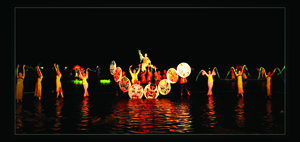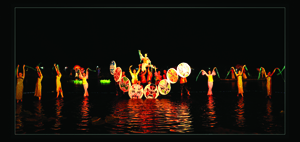(No.4, Vol.7,Aug-Sep 2017 Vietnam Heritage Magazine)

A performance at the Bung Binh Thien Festival, An Phu Dist., An Giang Province, 2015
Photo: Nguyen Thanh Liem

Cham people, one of ethnic groups living around Bung Binh Thien. Photo: Hong Be
Hanoi may boast of a sword from a lake, but only An Phu can boast of a lake from a sword
Bung Binh Thien is a huge fresh water body next to Binh Di river (a branch of Hau river) between Khanh Binh, Khanh An and Nhon Hoi communes of An Phu District, An Giang Province.
‘Búng’ in local dialect means a lake or swamp. ‘Bình’ means calm because the water in the lake is very calm. ‘Thiên’ means heaven. The name means ‘a peaceful lake given by heaven’ and takes roots from a legend about its origin.
As the legends go, late in 18th century, general Vo Van Vuong of the house of Tay Son moved to An Giang and chose this area to form a base camp and to accumulate provisions. In dry season the land was barren while the army needed water. The general set up an altar and conducted a ritual begging heaven and earth for water. Then he thrust his sword into the ground. A geyser of clear water jetted high. Soon it filled the lakes as we see today. Vo Van Vuong named the place Bung Binh Thien.
Actually there are two Binh Thien lakes which the locals call the Big One and the Small One. They both lie between Binh Di and Hau rivers, surrounded by 3-4m high mounds. The two rivers supply water for the lakes through natural gates. The lakes in turn supply an enormous amount of water to the local communities. They never run dry, even in dry arid season. The lakes are also the habitat for fresh water fish and aquatic plants such as lotus, water lily, nenuphar and algae. About 800ha around the lakes are covered by pristine forests. In dry season the Big One is about 6m deep on average and 193ha in area, and the Small One is 5m deep, 10 ha in area. In the rainy season, the two lakes swell to become a single vast expanse of water covered with lotus, nenuphar and other kinds of flowers. A strange thing never explained by science is that the silt-rich, turbid river water coming in to the lakes never disturbs the limpidity inside. Stranger yet, the lake water is seen to rise and recede but it never runs. There is a clear cut line separating the muddy and clear waters, which is the C3 bridge in Nhon Hoi village. The waters on its sides, though connected, look completely different. Cham people who have lived here the longest say that the algae in the lake bed cause this abrupt change in water quality. That makes Bung Binh Thien the largest fresh water body in the Southwest that features one of the most intriguing natural phenomena in the world.
At Bung Binh Thien, especially in the big water season from 7th to 10th lunar month, when river bean flowers dye yellow the earth, visitors can cruise the lake surface to enjoy the charms of nature, listen to heart-rocking, nostalgic old folk songs, and taste the best food southern common people have to offer such as field rats grilled with soya cheese, snakehead fish baked in embers, pickled fish soup with river bean flowers, tiny shrimps fried with river bean flowers, Siamese mud carp fried in flour coat and Siamese mud carp brined with tamarind. And leo, a black fish from the paddies, coming out to the lake with the rising waters, is a must. It is about 1m long in average, weighing 10-20kg, extremely strong, so much so it can break fishing nets. The fish is tasty and has high export value, worth about VND100,000/kg depending on the month.
Yearly in September, An Phu District, celebrates the Bung Binh Thien Festival, also to commemorate the district establishment. During the day visitors can take part in fun and folk game activities typical of the ‘big water season’ such as boat race, swimming conpetitions, raft race, fish-tackling and frog catching. At night they can watch a show on the water. There is no arena, no bright spotlights, just a huge expanse of water lined with millions of river bean flowers, and some water hyacinth floating amid the show numbers. The folk artists move on their triple board boats to perform, expressing love of the land and the people. At Bung Binh Thien, tourists can visit villages of Cham people who live by fishing and weaving traditional fabrics. Among the four ethnic groups living around Bung Binh Thien (Viet, Chinese, Cham and Khmer,) the Cham communities are the most unique and distinct because they have preserved most of their traditional lifestyle. Dense stilted houses surround a spacious Mas Jid Khoi Ri Yah mosque, where one can encounter old men coming to pray, beautiful Cham girls in traditional dress, or children playing happily on the streets.
*The article was printed on Sai Gon Giai Phong

From Chau Doc township center, cross Con Tien Bridge and follow Provincial Road no. 956 through An Phu town in Khanh Binh border gate direction to km23 100 which is Quoc Thai crossroad, turn left and go 2.5km further, and you see Bung Binh Thien.
,,
,,

